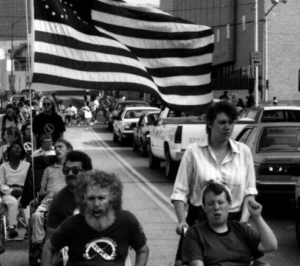Stories from the ADA Generation: Celebrating 30 Years
by Beth
 Moderating the Easterseals National blog has taught me that the most powerful way to communicate about disability issues is to share the voices and stories of the experts: real people with disabilities.
Moderating the Easterseals National blog has taught me that the most powerful way to communicate about disability issues is to share the voices and stories of the experts: real people with disabilities.
The Americans with Disabilities Act turns 30 at the end of this month, and with that in mind, I’ve been listening to the voices and stories of people with disabilities thanks to the audio version of a 2019 book called “From the Periphery: Real-Life Stories of Disability.” Author Pia Justesen spent four years talking with — and transcribing the accounts of — dozens of people who have disabilities, referring to those she talked with as “oral historians.”
Each chapter features an oral historian and Justesen starts with an unapologetic and respectful description of the person — along with an explanation of where the conversation took place and a short bit of background. Readers like us get to hear powerful, honest and compelling first-person accounts of what everyday life can be like when society treats you differently.
Justesen must have spent hundreds of hours talking with (and, especially, listening to) those oral historians — and she certainly gained their trust. The oral histories in this book are heartfelt, intelligent, and, well…real. My only problem with the book? Too many of the featured oral historians were, like me, over age 30. I would have liked to hear more from younger people with disabilities.
In the books foreword, retired Senator Tom Harkin, the Senate Author of the Americans with Disabilities Act in 1990, refers to people with disabilities born after the passage of the ADA as the “ADA Generation,” crediting them for understanding that the way they are treated now has more to do with their surroundings than with their individual impairments. From the foreword:
These are the young people who have been raised since the passage of the ADA, which banned discrimination on the basis of disability, began to change the physical structures, and empowered individuals with disabilities to assert their rights in court.
”Members of the ADA generation are not going to just sit back and accept anything less than full inclusion,” Harkin writes, pointing out that unlike so many of us living with disabilities before 1990, the up and coming ADA Generation understands that they are capable. They know the attitudinal, structural, and physical barriers in society (the ones many of us over age 30 figured we just had to live with) are unfair.
This got me to thinking… I moderate the Easterseals blog. If I want to hear from people who became disabled or were born with disabilities after the ADA was passed, why not ask people to write guest posts about their experiences with disability rights and discrimination? I could ask them how we should look at the ADA now, 30 years later. Maybe they’d have suggestions for changes to the ADA for the next generation – especially given the current climate of people talking about social justice and equality.
So I asked them. And guess what? They responded! Watch for their guest posts here starting this week and continuing right up to the 30th anniversary on July 26, 2020. Get ready for action!






